Aegithalidae facts for kids
Quick facts for kids Bushtits |
|
|---|---|
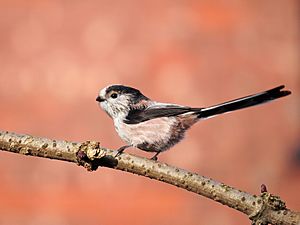 |
|
| Long-tailed tit Aegithalos caudatus | |
| Scientific classification |
|
| Kingdom: | Animalia |
| Phylum: | Chordata |
| Class: | Aves |
| Order: | Passeriformes |
| Superfamily: | Sylvioidea |
| Family: | Aegithalidae Reichenbach, 1850 |
| Genera | |
|
Aegithalos Hermann 1804 |
|
Bushtits, also known as long-tailed tits, are tiny birds. They belong to a bird family called Aegithalidae. There are 13 different kinds, or species, of bushtits. Most of them live in Europe and Asia, but one kind, the American bushtit, lives in North America.
These birds are always busy! They have long tails and fly around looking for insects in bushes and trees. When they are not raising their young, bushtits often live in big groups. These groups can have up to 50 birds. Some bushtit species even help each other raise their babies. This is called "helpers at the nest" behavior.
Contents
Where Bushtits Live
Bushtits are forest birds. They especially like the edges of forests and the understory, which is the area under the main trees. The bushtits in the Aegithalos group prefer forests where trees lose their leaves. The Indonesian pygmy bushtit mostly lives in mountain forests with cone-bearing trees.
You can find bushtits in many places. They sometimes live in dry areas with shrubs, but they are most common in mixed woodlands. Most bushtit species live in mountains near the Himalayas. All of them are found in Europe and Asia, except for the American bushtit. This bird lives in western North America.
The long-tailed tit is the most common bushtit. It lives all across Europe and Asia, from Britain to Japan. But two other species live in very small areas. The Burmese bushtit is found only on two mountains in Burma. The pygmy bushtit lives only in the mountains of western Java.
Bushtits usually do not migrate long distances. However, long-tailed tits in colder northern areas might move around more. Many mountain species move to lower places during the winter.
What Bushtits Look Like
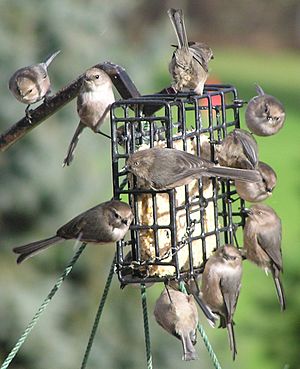
These are small birds. They are about 9 to 14 centimeters (3.5 to 5.5 inches) long. This length includes their long tail. They weigh only 4.5 to 9 grams (0.16 to 0.32 ounces).
Their feathers are usually dull grey or brown. Some species have white marks. The long-tailed tit has some pink colors. But the two Leptopoecile tit-warblers are much brighter. They have beautiful violet and blue feathers. The crested tit-warbler is the only one with a crest on its head.
Bushtits have tiny, short, and cone-shaped bills. Their wings are short and round. Their legs are quite long.
How Bushtits Behave
Bushtits live in groups that can have from 4 to over 50 birds. These groups form after one breeding season ends. They stay together until the next breeding season begins.
The birds in a group stay in touch using special calls. These calls are different for each species. Their songs are usually quiet or they do not sing much. Sometimes, other birds like tits or warblers will join a bushtit group to find food.
What Bushtits Eat
Bushtits are insect eaters. They mainly eat insects and other small creatures without backbones. This includes insects like leafhoppers, treehoppers, aphids, and caterpillars. Sometimes, in winter, they might eat plant parts like berries or seeds.
They usually look for food in trees. They often search in the lower branches or the top parts of trees. They rarely go down to the ground. They pick insects off branches, leaves, and buds. Less often, they catch insects while flying.
Bushtits are very good at moving around. They can even hang upside down on branches to find hidden food. They can also move branches and leaves to get to food.
Reproduction and Nests
Bushtits usually have one mate for life. However, the American bushtit might sometimes have more than one mate.
Pairs might get help from other birds. These "helpers" can be related or not. They help the main pair raise the young birds. This has been seen in at least four species. More research is needed to see if other bushtit species do this too.
Bushtits build dome-shaped or hanging, bag-like nests. They weave these nests using cobwebs and lichen. Then, they line the inside with soft feathers. Many nests are built in trees with lots of leaves. This makes them hard for predators to find. But the American bushtit often builds its nest where it is easy to see.
A female bushtit lays 5 to 10 white eggs. Many species have red spots on their eggs. The adult birds sit on the eggs for 13 to 14 days. The young birds stay in the nest for 16 to 18 days. In at least four species, only the female bird sits on the eggs. Young chicks are fed only insects and spiders.
Bushtit Family Tree
The bushtit family, Aegithalidae, was named by a German scientist named Ludwig Reichenbach in 1850. The name comes from an old Greek word for a tit bird. An ancient Greek thinker named Aristotle knew about three kinds of these birds.
The pygmy bushtit is thought to be part of this family. This is because it moves in groups and its nests look like those of the long-tailed tits. But we do not have much information about it. The Burmese bushtit is sometimes thought to be the same species as the black-browed bushtit.
The American bushtit was once thought to be in the chickadee family. But it has special behaviors, especially when it builds its nest. So, it was moved to the bushtit family.
There are 13 species of bushtits in 3 main groups, called genera.
| Image | Genus | Living species |
|---|---|---|
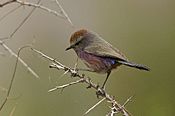 |
Leptopoecile Severtzov, 1873 |
|
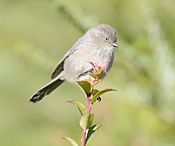 |
Psaltriparus Bonaparte, 1850 |
|
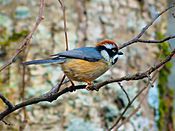 |
Aegithalos Hermann, 1804 |
|
See also
 In Spanish: Aegithalidae para niños
In Spanish: Aegithalidae para niños

